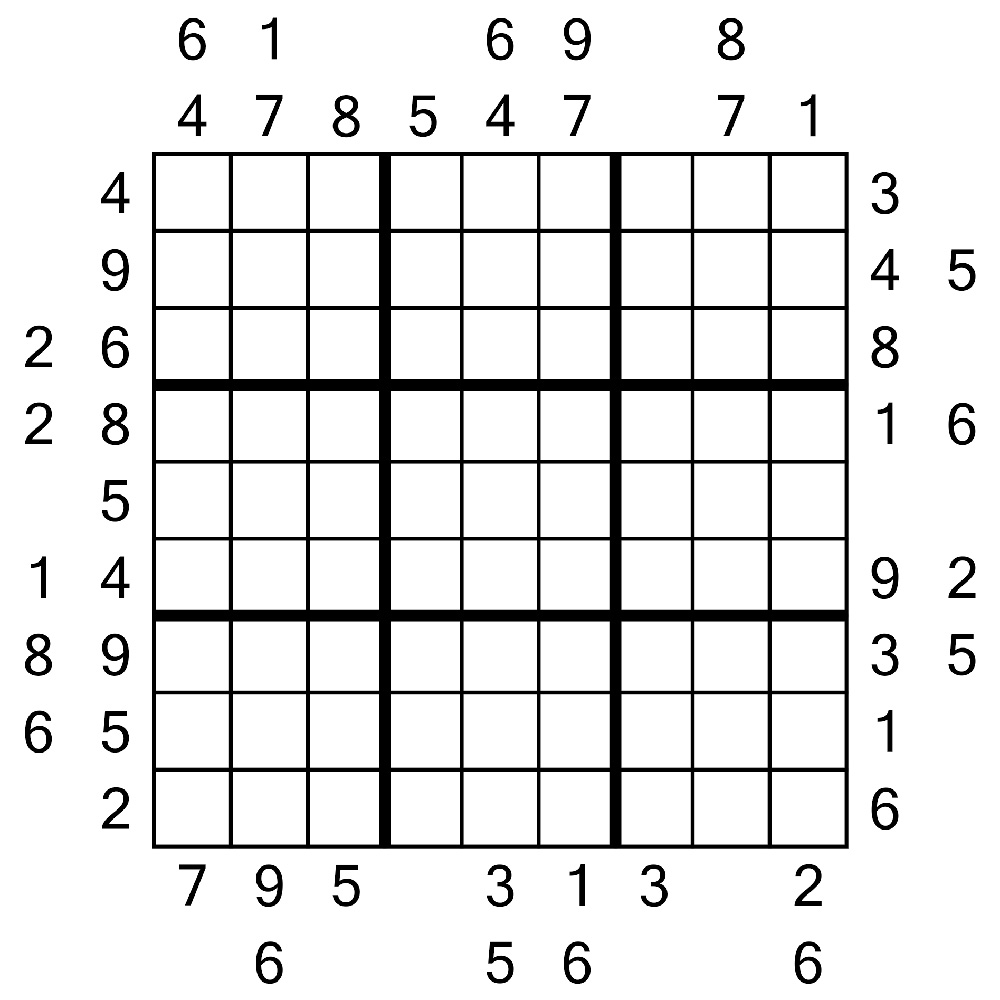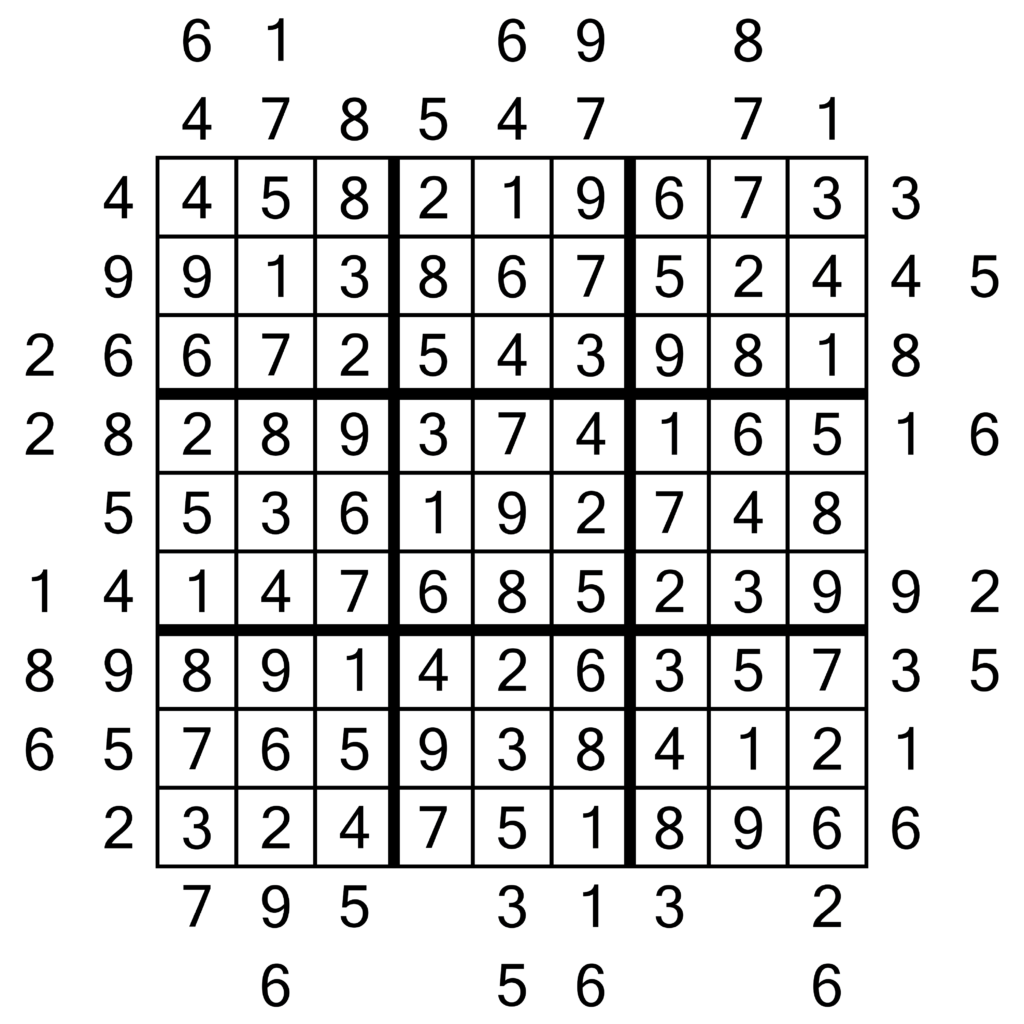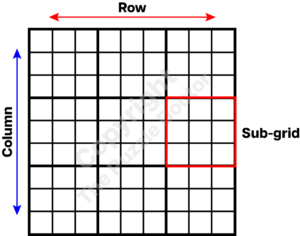Outside Sudoku
Welcome to the intriguing world of Outside Sudoku, a delightful twist on the classic Sudoku puzzle that offers an extra layer of challenge and excitement. Outside Sudoku, as the name suggests, takes the traditional 9×9 Sudoku grid and adds a twist – clues are provided outside the grid. This variant tests not only your logical reasoning but also your ability to think outside the box, quite literally!
In Outside Sudoku, numbers typically found within the grid in standard Sudoku are instead placed along the outside, adjacent to each row or column. These outside numbers serve as hints indicating which numbers must appear in the first three cells they touch in the corresponding row or column. The challenge lies in deducing the placement of numbers within the grid based on these external clues.


This puzzle is perfect for those who have mastered classic Sudoku and are looking for a fresh and innovative way to engage their puzzle-solving skills. Outside Sudoku requires a different approach, encouraging solvers to use deductive logic and strategic thinking in new and exciting ways. Whether you’re a seasoned Sudoku enthusiast or a newcomer eager to try something different, Outside Sudoku promises a rewarding and mentally stimulating experience. So, grab a pencil and get ready to embark on a unique Sudoku adventure that’s both familiar and refreshingly new!
How to Play Outside Sudoku
Understanding the Grid
The basic grid in Outside Sudoku is similar to classic Sudoku: a 9×9 grid composed of nine 3×3 sub-grids.
Clues Outside the Grid
Unlike traditional Sudoku, where clues are inside the grid, Outside Sudoku places them along the outside of the rows and columns. These outside numbers indicate which digits must appear in the first three cells (from the edge inward) in the corresponding row or column.
Filling in the Grid
Start with Outside Clues
Begin by looking at the numbers given outside the grid. These are your primary clues.
Apply Classic Sudoku Rules
Each row, column, and 3×3 box must contain all the numbers from 1 to 9, with no repetition.
Use Deductive Logic
Based on the outside numbers, determine which numbers can or cannot be in the first three cells of each row or column. Remember, these numbers can be in any order within the first three cells.
Cross-Referencing
Use numbers filled in from other rows and columns to help solve adjacent areas. Cross-referencing is a crucial strategy in Outside Sudoku.
Narrow Down Choices
As you fill in more numbers, the choices for the remaining cells will narrow down. Keep iterating this process.
Tips and Strategies
Start with corner grids
Look for clues in the corner sub-grids for columns and rows that match In the cell where matching clues intersect, fill in the number.
Most outside clues
Rows and columns with more outside clues will provide more information to help you solve
Open Singles
If a row, column, or block is missing only one number, fill it in.
Single Candidate
Look at the row, column, and sub-grids and determine if there is only 1 candidate. If there is, fill it in.
Look for minimal possibilities
By identifying cells or blocks limited to 2 or 3 possibilities, these possibilities can be eliminated from other cells or blocks.
Stay organized
Keep track of the strategies you’ve used and ones you may need to revisit as you fill out the grid.
Using Traditional Sudoku Strategies
Traditional Sudoku strategies play a crucial role in solving Outside Sudoku puzzles, even though the format of Outside Sudoku introduces unique elements. Here’s how you can apply standard Sudoku strategies to this variant:
Identifying Single Possibilities
In classic Sudoku, one common approach is to look for cells where only one number can possibly fit. This strategy is equally important in Outside Sudoku. After utilizing the outside clues, turn your attention to the grid and apply this fundamental Sudoku technique to find any cells with a single possible number.
Scanning for Missing Numbers
In a standard Sudoku puzzle, you often scan rows, columns, and 3×3 boxes to find missing numbers. This tactic is also useful in Outside Sudoku. Once you’ve placed some numbers using the outside clues, use the scanning method to determine which numbers are still missing in each row, column, and box.
Using Naked and Hidden Pairs/Triples
This technique involves identifying pairs or triples of numbers that can only go in two or three cells within a row, column, or box. These identified numbers can help you eliminate possibilities in other cells. In Outside Sudoku, after you’ve made some progress with the outside clues, look for these patterns within the rows, columns, and boxes.
Elimination Process
As with traditional Sudoku, you’ll often determine the number for a cell by eliminating all other possibilities in that row, column, or box. After placing numbers from the outside clues, use the process of elimination in other cells, considering the numbers that have already been placed.
X-Wing and Advanced Patterns
More advanced Sudoku strategies like X-Wing, Swordfish, and others, which involve looking at multiple rows and columns to eliminate possibilities, can also be applied in Outside Sudoku, especially for harder puzzles where basic strategies might not suffice.
Cross-hatching and Penciling In
Cross-hatching (scanning rows and columns to place numbers) and penciling in possible numbers in cells are foundational tactics in Sudoku. These can be used in Outside Sudoku once you have utilized the outside clues to fill in some numbers.
Applying these traditional Sudoku strategies in Outside Sudoku requires a bit of adaptation, particularly at the start of the puzzle when using the outside clues. However, once the puzzle starts to take shape, these methods become increasingly relevant and useful. As with any puzzle, the key is patience and practice – the more you solve, the better you’ll become at spotting these patterns and opportunities.
Outside Sudoku is a brain-teasing variation of the traditional Sudoku puzzle, blending the classic appeal of number placement with the added challenge of outside clues. With practice and patience, you’ll develop new strategies and skills to conquer these puzzles. Happy puzzling!